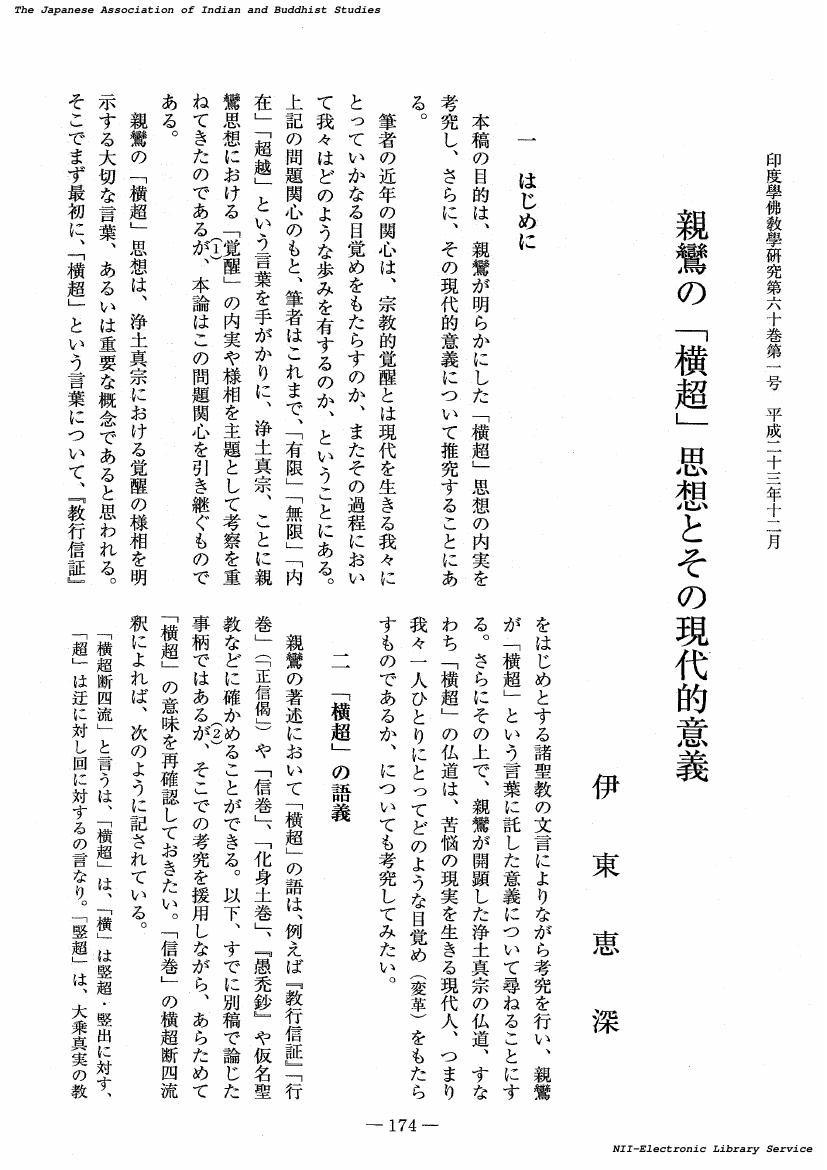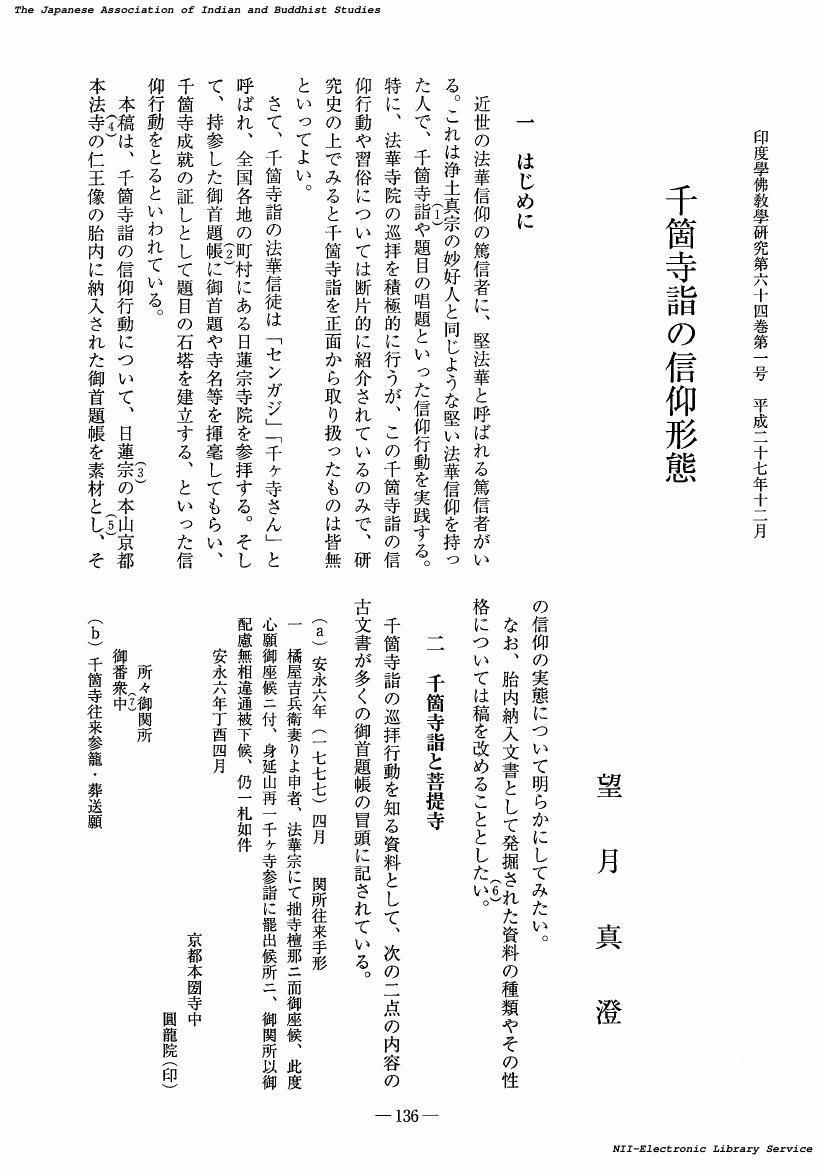1 0 0 0 OA 日本における須弥山論争の展開
- 著者
- 西村 玲
- 出版者
- 日本印度学仏教学会
- 雑誌
- 印度學佛教學研究 (ISSN:00194344)
- 巻号頁・発行日
- vol.61, no.2, pp.679-683, 2013-03-20 (Released:2017-09-01)
1 0 0 0 心地覚心の禅思想
- 著者
- 高柳 さつき
- 出版者
- 日本印度学仏教学会
- 雑誌
- 印度學佛教學研究 (ISSN:00194344)
- 巻号頁・発行日
- vol.63, no.1, pp.223-228, 2014
1 0 0 0 「其罪畢已」
- 著者
- 鈴木 隆泰
- 出版者
- 日本印度学仏教学会
- 雑誌
- 印度學佛教學研究 (ISSN:00194344)
- 巻号頁・発行日
- vol.65, no.3, pp.1147-1155, 2017
<p>『法華経』の「常不軽菩薩品」に登場する常不軽という名の出家菩薩は,増上慢の四衆にひたすら成仏の授記をし続け,そのことで彼らから誹謗,迫害を受けた.増上慢の四衆は常不軽を誹謗・迫害した罪で死後無間地獄に堕ちたが,自ら罪を畢え已わった後に常不軽と再会し,彼から『法華経』を教示され(=成仏の授記を受け),無上菩提へ向かう者となったとされる.ところが羅什訳の『妙法華』のみ,死時に臨んで常不軽が「其の罪,畢え已わって」(其罪畢已)としている.しかし,なぜ彼に罪があるのか,あるとすれば何の罪なのかが解明されないまま,今日に至っていた.</p><p>従来看過されていた事実として,Suzuki Takayasuは「常不軽菩薩品」に二種類の誹謗者が表されていることを明らかにした.二種類とは "『法華経』に出会う前の,『法華経』という仏語なしに無効な授記をしていた常不軽"(常不軽 ①)を誹謗した者たち(誹謗者 ①)と,"『法華経』に出会った後の,『法華経』という仏語をもって有効な授記をしていた常不軽"(常不軽 ②)を誹謗した者たち(誹謗者 ②)であり,後者の誹謗者 ② のみが,『法華経』説示者を誹謗した罪で堕地獄する.ところが『妙法華』のみ,常不軽 ② が『法華経』を説示していたという記述を欠いており,常不軽 ①と常不軽 ② との差違が判別しがたくなっている.</p><p>『法華経』の主張(『法華経』抜きに如来滅後に一切皆成の授記はできない.だからこそ,如来滅後にはこの『法華経』を説いて如来の名代として授記をせよ.如来のハタラキを肩代わりせよ)から判断して,常不軽 ① と常不軽 ② の差違は『法華経』にとって本質的であり,原典レベルで「其罪畢已」に相当する記述があったとは考えられない.羅什の参照した「亀茲(クチャ)の文」が特殊であったため,常不軽 ① と常不軽 ② との差違が判別しがたく,誹謗者 ① と誹謗者 ② を分ける必要が,漢訳段階で生じたものと考えるのが妥当である.しかし,そのために「其罪畢已」という文章を編み出したのは,羅什が『妙法華』訳出以前に『金剛般若経』を知っていたためと考えられる.</p><p>この「其罪畢已」という一節が,日本の日蓮に絶大な影響を与えた.日蓮宗の開祖である日蓮は,以前に念仏者・真言者であったため,「其罪畢已」の「罪」を過去の謗法罪と理解した上で,自らを常不軽と重ね合わせ,〈法華経の行者〉としての自覚を確立し,深めていった.</p><p>もし『妙法華』に「其罪畢已」の一節がなかったとしたら,日蓮は〈法華経の行者〉としての自覚を確立できず,その結果,『法華経』に向き合う姿勢を変えた可能性が高い.あるいは『法華経』信仰を捨てていた可能性まで考えられる.『開目抄』に見られる,「なぜ自分には諸天善神の加護がないのか」「自分は〈法華経の行者〉ではないのか」の解答の源は,「其罪畢已」以外には見出せないからである.</p><p>もし『妙法華』に「其罪畢已」の一節がなかったとしたら,中世以降今日に至る日本仏教は,現在とは大きく違った姿をしていたであろう.まさに,「大乗経典が外的世界を創出」(下田正弘)した好例である.『妙法華』に存するたった一個のフレーズ「其罪畢已」が,今日の日本の宗教界のみならず,社会の一側面を創出したのである.</p>
1 0 0 0 OA 「初発心時便成正覚」の一考察――中世真言学僧の華厳解釈を中心に――
- 著者
- 鈴木 雄太
- 出版者
- 日本印度学仏教学会
- 雑誌
- 印度學佛教學研究 (ISSN:00194344)
- 巻号頁・発行日
- vol.66, no.1, pp.84-87, 2017-12-20 (Released:2019-01-11)
- 参考文献数
- 2
“The First Inspiration to Set One’s Mind on Seeking Enlightenment” (Shohosshinjibenjōshōkaku) is a key term from the “Kegon Sūtra” concerning the theory of attaining Buddhahood in the Kegon sect. “Shohosshinjibenjōshōkaku” has been the subject of a variety of debates since ancient times.In this paper, I discuss the Kegon interpretations of Shingon priest-scholars (such as Raiyu, Gōhō, Shōken, and Shōdō), who were active during the Middle Ages, from the perspective of “Shohosshinjibenjōshōkaku.” As a result, I am able to clarify differences between the interpretations of Shingi Shingon scholar-priests and those of Kogi Shingon scholar-priests.Furthermore, the method by which each school understands the “ideal world” provides a background for the differences between the two interpretations.
1 0 0 0 OA 親鸞の「横超」思想とその現代的意義
- 著者
- 伊東 恵深
- 出版者
- 日本印度学仏教学会
- 雑誌
- 印度學佛教學研究 (ISSN:00194344)
- 巻号頁・発行日
- vol.60, no.1, pp.174-179, 2011-12-20 (Released:2017-09-01)
1 0 0 0 祭式で虚偽を語ってはならないのは何のためか-定動詞表示と文脈-
- 著者
- 吉水 清孝
- 出版者
- 日本印度学仏教学会
- 雑誌
- 印度學佛教學研究 (ISSN:00194344)
- 巻号頁・発行日
- vol.55, no.2, pp.820-814,1265, 2007
On the fourth section of the <i>Mimamsasutra</i> 3.4, Kumarila gives an extensive commentary whereby he criticizes the view that a finite verb denotes an agent. The original theme of this section, however, is to determine whether the Vedic injunction “One should not tell an untruth” (<i>nanrtam vadet</i>) embedded in the chapter of the new and full moon sacrifices prescribes a mode of performing a sacrifice or enjoins one to follow one's duty as a human being. The present paper elucidates how the linguistic discussion started by Sabara and developed by Kumarila with regard to a finite verb is related to the original theme of this section. Sabara and Kumarila have recourse to a grammatical maxim “A base (<i>prakrti</i>) and a suffix (<i>pratyaya</i>) express the meaning of the suffix together.” Patañjali quotes this maxim once with a modification of its meaning, and Paniniyas do not recognize the general validity of this maxim by confining its application to the rules of suffixes. Following <i>Astadhyayi</i> 3.4.69 and this maxim, however, the opponent of Kumarila asserts that the personal ending of “<i>vadet</i>” indicates an agent as the main element of the meaning of this verb. Kumarila, in retort, emphasizes that the agent of a Vedic sacrifice is an agent of the thinking prior to an action (<i>buddhipurvakarin</i>), who thinks what kind of result is expected to follow the action (<i>phalasankalpana</i>). If, by its personal suffix, the verb “<i>vadet</i>” denotes an agent to which the act of telling becomes subsidiary, one is inclined to keep away from telling an untruth in order to purify oneself and take the injunction out of context (<i>prakarana</i>) because one does not expect the injunction to have any indirect efficacy that may result from the contribution to the sacrifice. As a result of this self-centered interpretation, however, most injunctions would be prevented from their integration into the text. If, on the other hand, one convincingly refutes the theory that a finite verb denotes an agent, it becomes possible for the verb with a personal ending to denote <i>bhavana</i>, the general form of intentional actions, which requires the purpose (<i>sadhya</i>) and the requisites (<i>itikartavyata</i>) of the action. Both requirements are fulfilled by relevant injunctions within the context of the Veda. By criticizing the opponent's view, Kumarila intends to integrate Vedic injunctions in order to construct a unitary system of the sacrifice.
- 著者
- TANIZAWA Junzo
- 出版者
- 日本印度学仏教学会
- 雑誌
- 印度學佛教學研究 (ISSN:00194344)
- 巻号頁・発行日
- vol.41, no.2, pp.1149-1145, 1993
1 0 0 0 『一乗要決』における『涅槃経』の受容
- 著者
- 藤村 潔
- 出版者
- 日本印度学仏教学会
- 雑誌
- 印度學佛教學研究 (ISSN:00194344)
- 巻号頁・発行日
- vol.61, no.2, pp.584-588, 2013
- 著者
- 釋 覺瑋
- 出版者
- 日本印度学仏教学会
- 雑誌
- 印度學佛教學研究 (ISSN:00194344)
- 巻号頁・発行日
- vol.64, no.3, pp.1303-1309, 2016
- 被引用文献数
- 1
臨済義玄(?-866)と仏光星雲(1927-)は生まれた時期こそ千年以上離れているものの,二人とも彼らが暮らしていた社会に対して禅の教えを創造的に適用した.それは,人々が自らの人間性を発見し,現状を超越することへの一助とするためである.この二人の禅師は,様々な迫害を乗り越えただけでなく,先達の教えを作り変えることによって,その時代の社会・政治的な環境に新たな価値を付与し,当時用いられていた一般的な言葉を創造的に使い,彼等の信仰をさらなる高みへと引き上げた.中国禅の流派を形成した菩提達磨(5-6世紀頃)は『二入四行論』の中で,すべての衆生に等しく備わっている「本性」が存在していること(理入)と,菩薩がいかに日常生活において法に従いつつ六波羅蜜の実践が可能かということ(行入の四つの修行の一つ)を強調している.臨済義玄がこうした教えを適用したのは,四万以上の仏教施設が破壊され,二十六万人以上の僧侶が還俗を余儀なくされた会昌の廃仏後(845年頃)という惨憺たる時期であった.このような大規模な破壊-経典や信仰上価値のあるものを含む-と周辺地域での抵抗運動が続く中で,義玄は菩提達磨の法による「行入」に倣い,彼に付き随う人々を激励した.人生に起こった出来事をそのまま受け入れ,「あるべき」理想の人生と「いまこの」現実の人生の間に存在する緊張から解放したのである.達磨の「理入」と同じく,義玄は仏性を表す道教の用語「無位の真人⊥すなわちシンプルで自然な人間に戻ることを提唱した.この溌刺としてダイナミックな「真人」は,何物にも執着しないが故に,仏教徒はこうした超越的な解放(解脱)の状態を望むべきであり,不運な状況がふりかかろうとも抵抗しない,というのである.仏光星雲は臨済禅の系統に列なる人であり,「人間の生活の中の仏教」という太虚(1890-1947)の教えに影響を受けている.太虚は,制度や教育,社会の改善を通じて,広く仏教を活性化するよう呼びかけた人である.台湾の人々が急激な経済成長に自らをあわせ,儒教的な原理と資本主義的民主主義とのバランスを取るのに苦心している中で,星雲は太虚の活動を人道主義的な仏教へと転換したのである.星雲は法に従いつつ葬式仏教や伝統仏教を近代化した.それは仏教徒が,成長を続ける台湾の経済に生産的な面で貢献しながら,文化的,教育的,慈善的,修養的活動を通して,社会から疎外されている人を癒し,人々の連帯意識を生み出すためである.彼は智慧とユーモアと慈悲をもって,現代社会の厳しさとめまぐるしい変動に対応するために,禅のもつ解放的な性格を強調した.星雲は弟子達に,自らが仏である(理入)ということを主張するように勧めた.彼は,人々が自信を回復し,世界は縁起(空)から成り立っていると認識させることで,心の平静を取り戻させた.この二人の禅師は,人々が暮らす状況を十分に意識したうえで,彼等が理解できる言葉を使って,人々の自らに対する信頼を回復させ,社会の安定と成長に貢献した.精彩を放つ禅仏教の精神は,社会の利益と復旧に巧みに使われたのである.
1 0 0 0 OA 千箇寺詣の信仰形態
- 著者
- 望月 真澄
- 出版者
- 日本印度学仏教学会
- 雑誌
- 印度學佛教學研究 (ISSN:00194344)
- 巻号頁・発行日
- vol.64, no.1, pp.136-143, 2015-12-20 (Released:2017-09-01)
1 0 0 0 OA 中有に関するドルジェリンパの思想
- 著者
- 安田 章紀
- 出版者
- 日本印度学仏教学会
- 雑誌
- 印度學佛教學研究 (ISSN:00194344)
- 巻号頁・発行日
- vol.64, no.2, pp.961-956, 2016-03-20 (Released:2017-09-01)
1 0 0 0 白隠慧鶴と『宗鏡録』
- 著者
- 柳 幹康
- 出版者
- 日本印度学仏教学会
- 雑誌
- 印度學佛教學研究 (ISSN:00194344)
- 巻号頁・発行日
- vol.67, no.1, pp.292-286, 2018-12
1 0 0 0 千箇寺詣の信仰形態
- 著者
- 望月 真澄
- 出版者
- 日本印度学仏教学会
- 雑誌
- 印度學佛教學研究 (ISSN:00194344)
- 巻号頁・発行日
- vol.64, no.1, pp.136-143, 2015
1 0 0 0 日本近世における不殺生思想:――雲棲袾宏の受容と影響――
- 著者
- 西村 玲
- 出版者
- 日本印度学仏教学会
- 雑誌
- 印度學佛教學研究 (ISSN:00194344)
- 巻号頁・発行日
- vol.62, no.2, pp.753-757, 2014
1 0 0 0 普寂の実践観
- 著者
- 西村 玲
- 出版者
- 日本印度学仏教学会
- 雑誌
- 印度學佛教學研究 (ISSN:00194344)
- 巻号頁・発行日
- vol.53, no.1, pp.101-104, 2004
1 0 0 0 普寂の華厳理解
- 著者
- 西村 玲
- 出版者
- 日本印度学仏教学会
- 雑誌
- 印度学仏教学研究 (ISSN:00194344)
- 巻号頁・発行日
- vol.54, no.1, pp.256-260, 2005-12
1 0 0 0 日本における須弥山論争の展開
- 著者
- 西村 玲
- 出版者
- 日本印度学仏教学会
- 雑誌
- 印度學佛教學研究 (ISSN:00194344)
- 巻号頁・発行日
- vol.61, no.2, pp.679-683, 2013
1 0 0 0 求道恵尋の『円頓戒聞書』について
- 著者
- 窪田 哲正
- 出版者
- 日本印度学仏教学会
- 雑誌
- 印度學佛教學研究 (ISSN:00194344)
- 巻号頁・発行日
- vol.28, no.1, pp.264-266, 1979
- 著者
- 大観 慈聖
- 出版者
- 日本印度学仏教学会
- 雑誌
- 印度學佛教學研究 (ISSN:00194344)
- 巻号頁・発行日
- vol.64, no.2, pp.916-911, 2016
- 著者
- 堀田 和義
- 出版者
- 日本印度学仏教学会
- 雑誌
- 印度學佛教學研究 (ISSN:00194344)
- 巻号頁・発行日
- vol.66, no.2, pp.933-929, 2018
<p>Among the Indian religions, Hinduism and Buddhism treat earth, water, fire and wind as inanimate elements. However, in Jainism, these elements are treated as living entities. In the past, this Jain view of the elements was interpreted as showing that Jainism was animistic in outlook. Subsequently, however, many scholars have argued against this interpretation.</p><p>In this paper, I will first outline the existing scholarship that argues that Jainism is an animistic religion. Then, I will survey research critical of this view. Likewise, the view that Jainism must be old because it is animistic can also frequently be found. However, this view is based on the theory of the evolution of religion that has become the target of much criticism in recent years and therefore requires reexamination.</p><p>Next, I examine the counterargument by J. C. Jain. On the basis of the three points, I clarify the way in which his interpretation offers a valid counterargument to earlier scholarship.</p>



